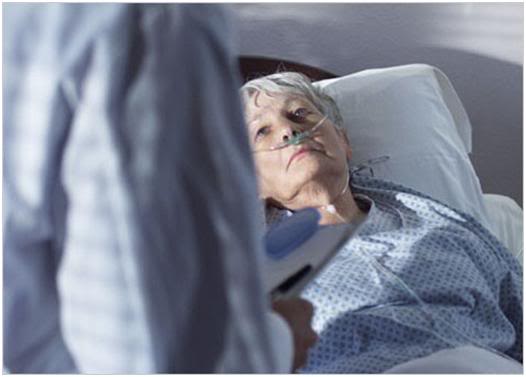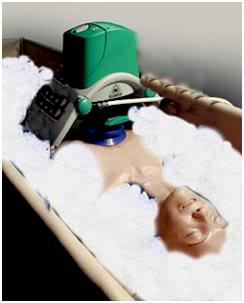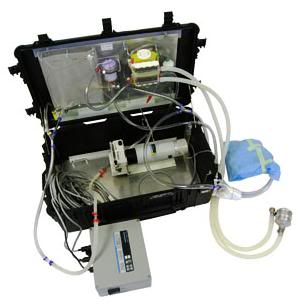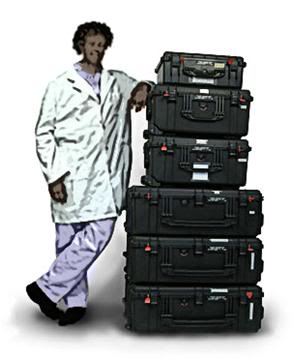 By Mike Darwin
By Mike Darwin
In the narrowest sense, Standby does not begin until cryonics organization personnel are deployed on-site to care for the patient. However, elements of peri-arrest care, such as counseling the patient and family, beginning a program of premedication, and carrying out site assessment and planning for Standby, are properly considered a part of Standby operations. A local standby is one in which medico-legal death is going to be pronounced in a location that is within easy reach by ground transportation from the operating room maintained by the cryonics organization. If the organization owns an ambulance, or similar special-purpose vehicle, most of the necessary supplies and equipment required to facilitate Stabilization and Transport should be present, and already organized in the vehicle, so that they can be quickly moved to the patient’s bedside. If the cryopreservation organization does not own an ambulance, supplies will need to be organized into a kit which can be transported to the patient’s location by other means. It should be noted that reliance on commercial providers of patient transport such as mortuaries, removal services, and ambulance companies is problematic and presents many possible legal and logistic pitfalls. Because of this, this option should be used only as last resort or a ‘stop gap’ in an emergency.
 Figure 5: Standby and stabilization require meticulous preparation and the deployment of a substantial amount of equipment and supplies. At right, a LUCAS cardiopulmonary support device is shown in place on a mock patient in a Portable Ice Bath (PIB). In addition to these (and many other) items of equipment, ice in large quantities must be on-site and immediately available.
Figure 5: Standby and stabilization require meticulous preparation and the deployment of a substantial amount of equipment and supplies. At right, a LUCAS cardiopulmonary support device is shown in place on a mock patient in a Portable Ice Bath (PIB). In addition to these (and many other) items of equipment, ice in large quantities must be on-site and immediately available.
A Remote Standby occurs where the patient is far enough from the cryopreservation facility for air transportation to be the preferred means of access. In this situation, the cryopreservation organization will dispatch its personnel, usually by common carrier, together with most of the equipment and supplies required to perform initial cardiopulmonary support, extracorporeal support, total body washout (i.e., blood washout with a tissue preservative solution), and refrigerated transport of the patient (again, usually by common carrier) back to the operating room for cryoprotective perfusion. For a remote transport to be performed successfully, there must be meticulous preparation and attention to detail. The Remote Standby Kit (RSK) must be carefully stocked and organized to anticipate a wide range of contingencies.
Whether a standby is local or remote, if a patient is going to receive stabilization at home and/or with the assistance of a mortuary, it is almost essential that the Transport Technician should visit the patient’s home, meet the family and the mortuary staff in person, and inspect their facilities in advance. If the home has a garage, it may be usable as a field operating room to allow extracorporeal support and blood washout immediately after legal death. The home must also be evaluated to insure that the Portable Ice Bath (PIB) or Extracorporeal Membrane Oxygenation (ECMO) cart can be moved in and out in a fully loaded condition, using available personnel.
Mortuary facilities must be similarly evaluated to insure that the Preparation Room (embalming room) has adequate space, lighting, and electrical outlets to allow for both the heart-lung resuscitator and extracorporeal support. Mortuary personnel must be instructed to remove ambulance cot(s) or gurneys from transport vehicles to make room for the PIB, if this is going to be used. Mortuary personnel must also be carefully briefed on the equipment that will be used and on the need to keep personnel and oxygen beside the patient during the journey to the mortuary from the home, hospital or nursing home. All personnel musty be brief on safety issues of importance in the Stabilization and Transport setting, such as the extreme danger of using oxygen or an open flame in a closed vehicle wile oxygen driven CPS equipment is in operation!
 Figure 6: A Thomas Pack filled with Stabilization medications and ancillary supplies is an effective way to organize these items. This kit is one used by the Alcor Life Extension Foundation.
Figure 6: A Thomas Pack filled with Stabilization medications and ancillary supplies is an effective way to organize these items. This kit is one used by the Alcor Life Extension Foundation.
Just as important as what is in the RSK is what is not. It is both illegal and impractical to ship oxygen by common carrier. Thus, it will be critical to insure that an adequate amount of oxygen is available on-site. Similarly, it is impractical to transport ice and this key material will also have to be acquired locally. Mortuary, medical (nurse and physician), and other personnel will need to be obtained locally, and transportation for both equipment and transport personnel will need to be arranged. The transport team must be ready and willing to explain the principles of human cryopreservation, and must have a clear plan of action which spells out the roles and duties of everyone involved. They must also have documents (cryopreservation paperwork) proving that they have necessary legal authority to act. A hold-harmless or other release of liability may also be needed to reassure local medical personnel and others who are reluctant to get involved in a procedure that seems unfamiliar and potentially threatening.

Figure 7: Standby typically includes blood substitution with a tissue preservative solution, and may sometimes involve extended extracorporeal cooling using a system such as the one at left, that was developed by the Alcor Life Extension Foundation in the late 1990s.
With the advent of home-hospice care, legal death of patients at home is becoming increasingly common. In situations where adequate notice of impending legal death exists, it will be of great importance to determine the best location for legal death to occur.
Organizations that offer Standby must have an objective, evidence-based prognostication program which serves as the basis for initiating and continuing Standby. At a minimum, this will consist of the integrated use of a scoring system for predicting the time-course to cardiac arrest in slowly dying patients (i.e., those with cancer and other relentlessly progressive terminal illnesses) such as the Karnofsky Performance Scale: http://www.pennmedicine.org/homecare/hcp/elig_worksheets/Karnofsky-Performance-Status.pdf ,[106, 107] and a mix of acute illness and trauma survival prognostication tools such as the APACHE II (Acute Physiology and Chronic Health Evaluation): http://www.sfar.org/scores2/apache22.html,[108, 109] SOFA (Sequential Organ Failure Analysis): http://www.sfar.org/scores2/sofa2.html,[109-115] TRISS (Trauma – Injury Severity Score): http://www.trauma.org/index.php/main/article/387/[116] and IMPACT (International Mission for Prognosis and Analysis of Clinical Trials in Traumatic Brain Injury): http://www.tbi-impact.org/?p=impact/calc[117, 118]. The protocol for the use of these tools in initiating Standbys must be publicly available, and subject to comment and review. The transparency of this protocol is of great personal and financial importance to the member, since the conditions under which Standbys are launched and maintained will ultimately determine the likelihood of the member personally benefitting from the service and , of course, directly or indirectly, the cost he will pay for Standby service.
 Figure 8: A typical Remote Standby Kit packed in rugged, shock-resistant Pelican Cases and ready for deployment (photo courtesy of the Alcor Life Extension Foundation).
Figure 8: A typical Remote Standby Kit packed in rugged, shock-resistant Pelican Cases and ready for deployment (photo courtesy of the Alcor Life Extension Foundation).
The organization must also maintain and use a Standby Manual which complements its Stabilization and Transport Manual. The Standby Manual provides comprehensive instruction for personnel in dealing with the terminally ill member and his family (psycho-social considerations), evaluation of Transport logistics, interfacing successfully with the patient’s health care providers and the patient’s C/ME, and working with the patient’s primary care physician to institute a medically appropriate, and medically acceptable program of pre-medication to reduce ischemia-reperfusion injury. The Standby Manual will also contain SOPs for laboratory monitoring of the patient during his terminal illness to allow for more accurate estimation of the likely time to cardiac arrest, as well as a determination of the patient’s Total Antioxidant Capacity (TAC) and redox status prior to cardiac arrest. These latter measurements establish a baseline that is critically important in determining the effectiveness of both premedication and post-arrest pharmacological interventions to minimize ischemia-reperfusion injury. An example of a basic Standby Manual may be found at: http://www.cryonics.com/Library/html/standby.html.
Why These Things are Important
It should be self evident that careful assessment of the patient and his environment are important to having a good outcome from Standby. If the family members, close friends, or other caregivers attending the patient are hostile, or even simply indifferent to the patient’s desire for cryopreservation, the likelihood of a successful Stabilization and Transport are greatly diminished, if not altogether eliminated. It is therefore essential that, to the extent possible, these individuals be thoroughly evaluated. This can only be done properly by meeting with them in person in the home setting and working cooperatively with them to ensure that the patient’s cryopreservation related needs will be met when the time comes.
This is a two way street, in that not only is it important that those caring for the patient know what is expected of them, the cryonics organization must also know what the family/caregiver’s needs are, both logistically and psychologically. Cryonics is unfamiliar territory for family, and the procedures attending Standby and Stabilization can perturb what in many cases will be a fragile emotional and psychological equilibrium in the patient’s home life. Organizations that fail to establish rapport, and work to ascertain and meet the needs of the patient’s family, risk non-cooperation, obstruction and even litigation. Seemingly small details, such as protecting flooring or furniture from water damage, or arranging for a few minutes of private “alone time” with the patient before he is removed from the home or care facility after acute stabilization, can mean the difference between heartfelt assistance, and bitter belligerence from the next of kin.
Assessment of the logistics of each case is also essential. Is there space to store equipment prior to use? Can the patient be relocated from a back or upstairs bedroom to the living room or other more accessible space so that valuable time is not lost trying to gain access to the patient, or to remove him and the cardiopulmonary support equipment from the residence or care facility? These issues, and many others like them, can only be dealt with by on-site, person-to-person contact. The personnel required to carry out this type of communication and cooperation must be both technically knowledgeable and emotionally intelligent; absent both these assets, the likelihood of failure increases.
 The use of patient cardiac arrest assessment or “mortality assessment” tools in a rigorous and evidence-based fashion is essential both to “getting it right” in terms of not being too late to arrive on the scene, and in containing costs by not deploying to early, or conversely, deploying under circumstances where the patient is not truly at high risk of arresting. No one prognostication tool will do the job, and in fact, it will simply not be possible in many cases to determine with any degree of precision when the patient will experience cardiac arrest. However, in the case of clearly terminal patients dying from inexorably fatal illnesses, such as end stage cancers, or untreatable multiple organ failure, the use of prognostic tools such as the Karnofsky’s Performance Assessment and the APACHE II and SOFA scoring systems (where laboratory data are available can be obtained) will help reduce uncertainty, and will definitely identify a significant subgroup of patients who will experience cardiac arrest within a window of two days, to a week at most.
The use of patient cardiac arrest assessment or “mortality assessment” tools in a rigorous and evidence-based fashion is essential both to “getting it right” in terms of not being too late to arrive on the scene, and in containing costs by not deploying to early, or conversely, deploying under circumstances where the patient is not truly at high risk of arresting. No one prognostication tool will do the job, and in fact, it will simply not be possible in many cases to determine with any degree of precision when the patient will experience cardiac arrest. However, in the case of clearly terminal patients dying from inexorably fatal illnesses, such as end stage cancers, or untreatable multiple organ failure, the use of prognostic tools such as the Karnofsky’s Performance Assessment and the APACHE II and SOFA scoring systems (where laboratory data are available can be obtained) will help reduce uncertainty, and will definitely identify a significant subgroup of patients who will experience cardiac arrest within a window of two days, to a week at most.
While it is not possible to predict with precision when a patient with a Karnofsky score of 20 (very sick; hospital admission necessary; active supportive treatment necessary) will experience cardiac arrest, it is possible to know with a high degree of certainty that cardiac arrest is imminent. Even if this knowledge does not permit immediate deployment of a Standby Team, it may allow for local volunteers to be alerted and to be available, or on – call should the patient arrest sooner than expected, or before the Standby Team can arrive. It also allows for the placement of last minute supplies such as perfusate, extra oxygen, or the start of in-home storage of large quantities of ice in well insulated picnic chests.
The effective use of these tools and deployment of the necessary resources requires extensive documentation in the form of checklists, standard operating procedures (SOPs) (Best Practice in Europe and the Near East), and a comprehensive Standby Manual. Any cryonics organization offering Standby should have such tools and make them available for inspection and evaluation by members and clients, longstanding or prospective.
End of Part 3
